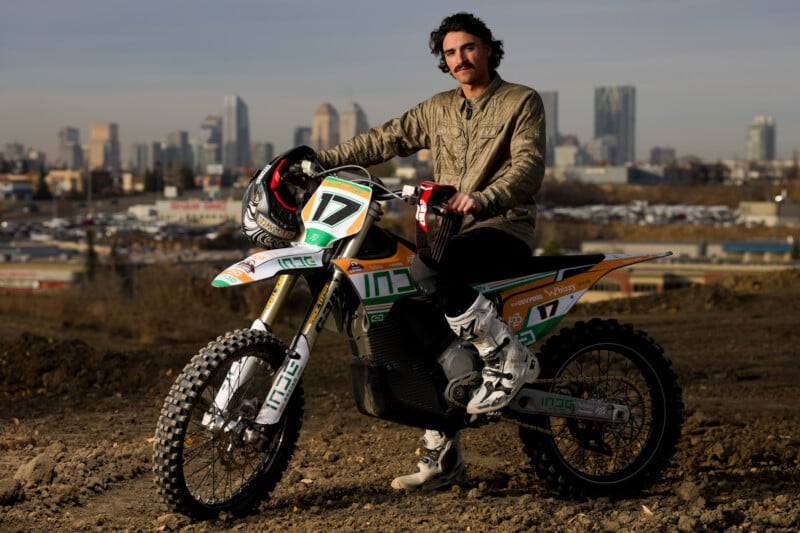
The original Sony a1 is one of the most capable, advanced, and expensive flagship cameras ever. When it first came out, it wowed potential buyers with a fast-scanning 50-megapixel sensor without major rolling shutter issues while offering fast burst rates. It has been almost four years since then, and now we have a version II from Sony in our hands. Does the apple fall far enough from the tree to make it worth the $6,500 cost?
Sony a1 II First Impressions: An a9 III and an a1 Had a Baby
In the last four years, we have seen Sony revamp menus, change body designs, and even release the a9 III global-shutter camera. On the outside, the a1 II gets the latest body design from the a9 III with a compact design that can handle rough environments. We also get the latest menus with the new home page on the menu, just like the a9 III. We also have the same 9.44-million dot EVF as the a9 III and a similar 2.1-million dot back LCD panel with the modern 4-axis Sony articulation. I’m starting to see a pattern here.

In fact, the body design is effectively identical to the a9 III even down to the addition of the new customizable “boost” button beside the grip. Ultimately, this is a good thing because I feel like Sony has refined its user experience over the years to now make very intuitive body designs. The body is a marked improvement over the original a1, and it even shaves a little weight off, bringing the a1 II down to a svelte 21.76 ounces (617 grams). You also get the usual twin CF Express type A slots and excellent Z-type battery. Even the IBIS is modernized to the latest standard, offering roughly eight stops of stabilization overall. All the ports you would expect are present, from the full-size HDMI to an Ethernet port, headphone, and mic jack.


Granted, a lot has been improved on the a1 II to bring it up to the latest Sony standard but what about the internals? This is almost the opposite story, as we soon realized the guts are essentially the same as the original.


The 50-megapixel sensor is the same one we had in the original a1. This is not a negative because, frankly, the original sensor was way ahead of its time. Combining high resolution with fast scanning speeds makes the a1 II an excellent choice for almost any kind of photography, from landscapes to sports and wildlife. The a1 II still shoots up to 30 fps when shooting RAW using lossy compression. The sensor scans at roughly 1/250th of a second, which is very respectable today, let alone four years ago.


The a1 II also has an advanced mechanical shutter, which offers a maximum flash sync speed of 1/400th of a second with compatible TTL flashes and even 1/500th with an APS-C crop factor. When needed, the mechanical shutter can drive 10 pictures per second in full-res RAW.

However, given the fast nature of the Sony a1 sensor, I rarely shoot it using the mechanical shutter, and if I want to stick to lossless compression RAW files, I still get a blazing 20 fps. Regardless, although the a1 II offers the same shooting speeds as the original and remains competitive against today’s cameras. The a1 II’s internals are “old” in a strict sense but do not feel outdated.


Sony a1 II First Impressions: A Field Test Home and Abroad
I always liked the older Sony autofocusing results ever since they debuted Real-Time tracking. However, the a9 III illustrates how far Sony AF has come, using the latest autofocusing algorithms coupled with a global shutter, which makes it the best-focusing Sony camera to date.

The new a1 II has the same algorithms and gets features that its predecessor didn’t have, like insect subject detection or all the new planes, trains, and automobile modes. It also makes a lot of autofocusing calculations while shooting thanks to the fast sensor, which won’t quite make it focus as well as the a9 III, but it gets pretty darn close.


I primarily wanted to shoot the a1 II as a sports camera this time and Sony gave us an ideal opportunity to shoot an NFL game at the MetLife stadium. I got to shoot the Sony a1 II from the sidelines, documenting a close match between the Jets and the Colts. The a1 II did a great job in Calgary shooting Motocross, where the action is repeatable and predictable, but professional football proved to be a very challenging subject matter. With so many players on the field, the Sony a1 II had many subjects to choose from, and the very nature of football, with its intense, unpredictable action and the challenge of following said action, further complicated the issue.


The autofocusing was as reliable as ever, with Real-Time tracking excellently staying on players throughout the action. The camera could be fooled into focusing on a different player than intended, but that is not so much the camera’s fault as it is mine to get the focusing point in the right spot during the intense scrimmages. Overall, I had a good success rate, and the AF performance was something I could count on in a fierce action situation. Players wearing helmets can make eye detection tricky, but the a1 II was able to intelligently track faces when it could see them or torso and body tracking when it couldn’t.


I preferred 20 fps bursts for most of the day and had the confidence to capture critical moments. The a1 II has a pre-capture mode, which is handy, and the lack of viewfinder blackout lets me follow along with the action. I used the EVF at a 120Hz rate, which gave smooth and natural-looking fluidity to the scene, and I didn’t feel the need to push it to 240Hz — 120 is plenty swift. Curiously, Sony confirmed that there is a slight loss of resolution at 120Hz, but I struggled to notice it. However, the resolution drop at 240Hz is clearly visible.


Sony a1 II First Impressions: A True Flagship Camera
Having recently tested the Canon 24-megapixel EOS R1, I appreciate the higher-megapixel count of the a1 II for sports. The Canon R1 is a blazingly fast and capable sports camera, but I found myself cleaning up compositions here and there with the a1 II or even switching to a rotated composition. Those 50 megapixels gave me room to do so in those situations.

Beyond this, the image quality and detail from the a1 II make it more appropriate for studio or landscape photography than the R1, R3, or a9 III. The a1 II is every bit the flagship camera in Sony’s lineup that its predecessor was, meaning the camera can handle everything you throw at it. It is not a niche, specialized camera like some similarly-quick competitors.


A Brief Aside: The Sony a1 II as a Landscape and Nature Camera
Jeremy Gray here for a quick digression. I also had hands-on time with the a1 II, although I focused my efforts on a bit of night sky photography and landscape work. While the a1 II is a powerhouse for action photography, as Chris has demonstrated with his excellent motocross and football photos, the a1 II is also uniquely positioned in Sony’s lineup as its “do everything at a high level” camera, meaning it is an exceptionally compelling option for landscape, nature, and wildlife photography.

While I was unable to grab wildlife shots during my time with the camera, given that I was working with Sony’s new, amazing FE 28-70mm f/2.8 GM lens, I was able to test the camera for more general nature and landscape work. The a7R V is undoubtedly Sony’s best option for strictly landscape shooting, but for people who dabble in wildlife, the a1 II carves out a niche. The a9 III’s autofocus and performance are great, but you leave some dynamic range and considerable resolution on the table. The a1 II does not leave resolution on the table, and manages to be super quick, too, able to capture all but the absolute fastest action.


I’ve shot quite a bit with the original a1, and although the camera never lacked autofocus performance in my view, the improvements the a1 II brings to the table are noticeable, albeit not necessarily groundbreaking. The autofocus is a bit quicker, a bit snappier, and thanks to the automatic subject detection, more intelligent.
![]()
![]()
While the autofocus improvements are great, and the addition of pre-capture burst shooting is a big deal for sports and wildlife photography, when the best moments are often unpredictable and fleeting, the a1 II’s handling improvements impressed me quite a bit during my hands-on time. While the a9 III’s global shutter and all the resulting performance improvements are obviously amazing, the improvements to the usability and overall shooting experience was nearly as impressive.
![]()
Now that these have made their way to the a1 series, the a1 II is a nearly perfect camera from a handling perspective. Sony has made huge strides in ergonomics since the original a1 landed, so with the a1 II, Sony’s best overall camera is finally in lock-step with its recent models in terms of handling, AI features, and the overall user experience.

![]()
I’m not convinced these improvements are worth it for someone to upgrade from the original a1, but if a nature or wildlife photographer was moving up from a mid-tier Sony model, like an a7 series body, or getting their first Sony camera, the a1 II is a very attractive option, albeit a really expensive one.
![]()
The Sony a1 II Is Mostly More of the Same for Video, With Some Welcome Improvements
As a hybrid video camera, the quality is the same as the original a1, but the newer version does get some quality-of-life improvements.
The new four-axis tilt screen should please photographers and videographers alike; the autofocusing performance is more reliable in video mode, you get improved IBIS stability, and you can now load custom LUTs to assist with your Log recordings. The a1 II is no slouch for cinematic work and has all the latest Sony video assist tools and focus breathing compensation. Jordan shot a majority of our YouTube review on the a1 II and found the camera to be very capable.

The Sony a1 II Is a Phenomenal Camera But Not the Revolution Compared to Its Predecessor
So the real elephant in the room will be the expensive price of admission with the Sony a1 II. Just like the original, the $6,500 price tag can cause severe sticker shock and it’s important to note that the original version offered a product that stood far above the competition.
The a1 II is an excellent camera but it has some stiff competition on a more level playing field. The Canon EOS R1 is pretty close in price though and does not offer nearly the same versatility but the R5 II is substantially cheaper and gives fairly similar performance. The other major competitor will be the Nikon Z8 or Z9, which are available for much less money (the Z8 is on sale right now for $3,500 — a full $3,000 less than the a1 II).

The Sony a1 II is undoubtedly a more capable camera than the competition in many ways. It has a higher resolution EVF, superior four-axis display panel, and excellent IBIS. But the differences are minor for many applications, and a more in-depth comparison is definitely in the cards.
While the original a1 was light-years ahead of the competition at the time of its launch which helped to justify the high price of admission, the a1 II’s advantages are relatively less substantial this time around. It is still Sony’s best all-around camera but the competition has caught up significantly in the last couple of years.
Sony users who don’t need the same action and sports capability but still want high image quality should certainly look at the a7R V instead. However, there is no denying that the Sony a1 II is the highest-tier option and stands as one of the best modern mirrorless cameras that money can buy. If you do pick one up, you won’t be disappointed by what it can do.
creditSource link







